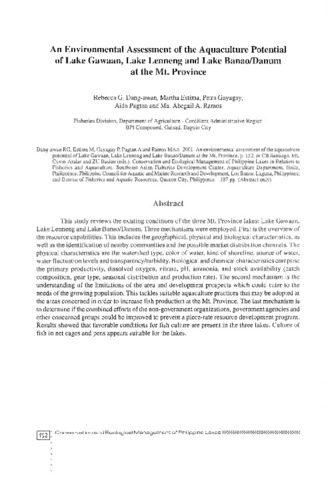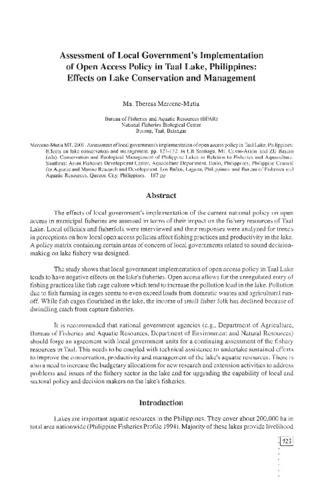Fish cage and pen aquaculture: Impact on lake environment
| dc.contributor.author | Fortes, Romeo D. | |
| dc.contributor.editor | Cuvin-Aralar, Maria Lourdes | |
| dc.contributor.editor | Punongbayan, Raymundo S. | |
| dc.contributor.editor | Santos-Borja, Adelina | |
| dc.contributor.editor | Castillo, Lourdes V. | |
| dc.contributor.editor | Manalili, Eduardo V. | |
| dc.contributor.editor | Mendoza, Marlynn M. | |
| dc.date.accessioned | 2021-07-27T08:25:00Z | |
| dc.date.available | 2021-07-27T08:25:00Z | |
| dc.date.issued | 2005 | |
| dc.identifier.citation | Fortes, R. D. (2005). Fish cage and pen aquaculture: Impact on lake environment. In M. L. Cuvin-Aralar, R. S. Punongbayan, A. Santos-Borja, L. V. Castillo, E. V. Manalili, & M. M. Mendoza (Eds.), Proceedings of the First National Congress on Philippine Lakes (pp. 239-244). Southeast Asian Regional Center for Graduate Study and Research in Agriculture (SEARCA). | en |
| dc.identifier.issn | 1656-8099 | |
| dc.identifier.uri | http://hdl.handle.net/10862/6146 | |
| dc.description.abstract | The continuous utilization of the aquatic resources of the Philippines - both fresh and marine waters -for food and feeds including export of fish and other fishery products, had resulted to greater exploitation of these resources. Despite these, a deficit is attained which is filled up by the government through importation. To reduce fish importation, there is a need to tap other resources. Coastal marine resources is overexploited, thus, off-shore or deep-water aquaculture has been introduced. The development of freshwater aquaculture has been envisioned to expand where pens and cages in lakes and rivers shall dominate. The contribution of aquaculture to fish production is very significant and has been identified as the sub-sector that will play a major role in enhancing fish production of the country. Given the above scenario, and focusing only on lakes, this paper aims to identify various aquaculture activities in lakes that have negative impact on the lake environment. It hopes to be able to recommend means by which aquaculture could play more significantly not as a means for greater exploitation but as an agent of conservation, protection, rehabilitation, and sustainable utilization of these resources. The impacts of fish cage and pen aquaculture in aquatic bodies included: enrichment of aquatic ecosystem; pollution of adjacent habitats; deterioration of water quality; increased interaction with wildlife resulting to enhanced vulnerability to parasites and diseases; reduction of species diversity, including socioeconomic issues like displacement of rural communities, exclusion of traditional fisherfolks and navigational hazards; and other social and political implications. The expectation from both the government and the public is to support each other by being conscious of the commitment of the government to the three Earth Summits. To the future generation, the expectations are to come up with implementable policies and to have the political will to enforce the laws that originate from the citizens, not from the whims of political leaders and legislators. | en |
| dc.language.iso | en | en |
| dc.publisher | Southeast Asian Regional Center for Graduate Study and Research in Agriculture (SEARCA) | en |
| dc.subject | Fish cages and pens | en |
| dc.subject | Lake aquaculture | en |
| dc.subject | Impact of aquaculture | en |
| dc.title | Fish cage and pen aquaculture: Impact on lake environment | en |
| dc.type | Conference paper | en |
| dc.citation.spage | 239 | en |
| dc.citation.epage | 244 | en |
| dc.citation.conferenceTitle | Proceedings of the First National Congress on Philippine Lakes | en |
| dc.subject.asfa | cages | en |
| dc.subject.asfa | lakes | en |
| dc.subject.asfa | aquaculture | en |
| dc.subject.asfa | stocks | en |
| dc.subject.asfa | fishery products | en |
| dc.subject.asfa | fauna | en |
| dc.subject.asfa | flora | en |
| dc.subject.asfa | feeding | en |
| dc.subject.asfa | feeds | en |
| dc.subject.asfa | harvesting | en |
| dc.subject.asfa | government | en |
Files in this item
| Files | Size | Format | View |
|---|---|---|---|
|
There are no files associated with this item. |
|||
This item appears in the following Collection(s)
-
LakeCon2003 [49]
Proceedings of the First National Congress on Philippine Lakes



